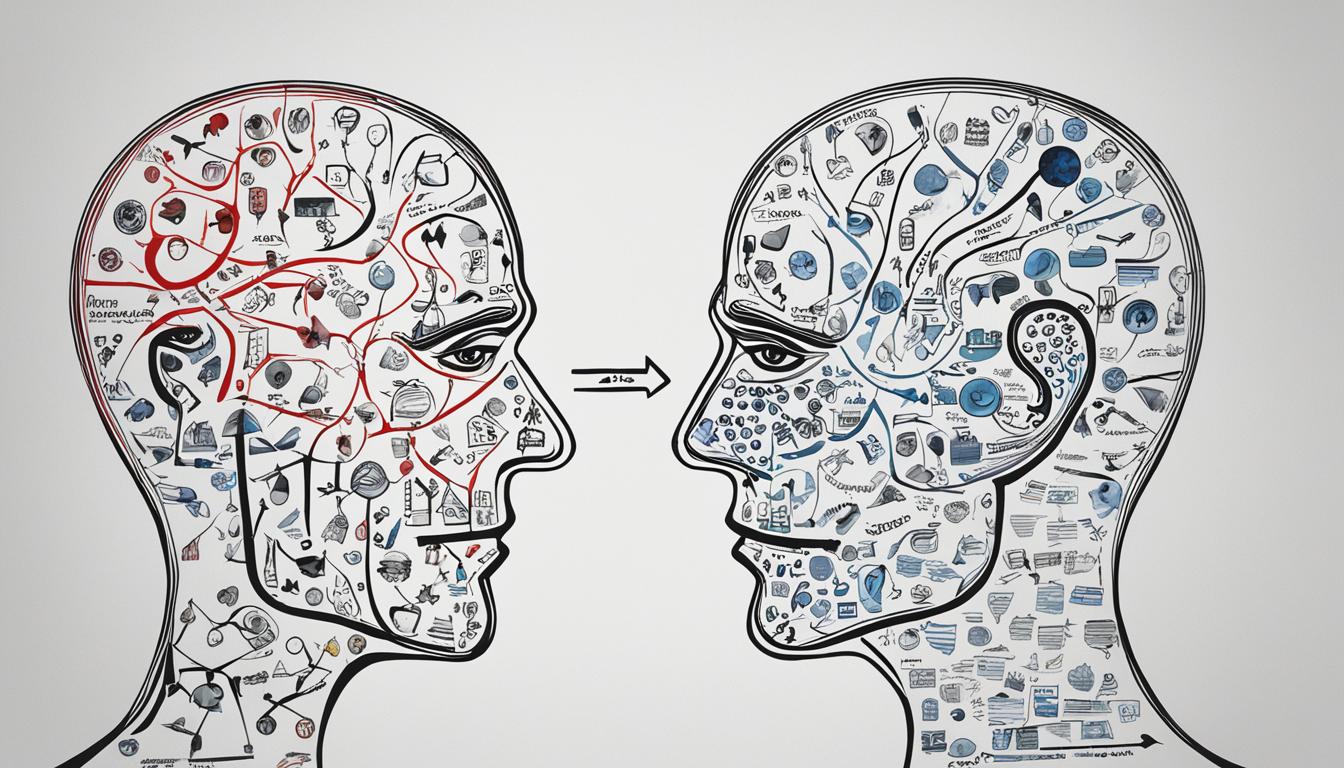It is interesting how many of us have come across individuals whose behavior exhibits characteristics that could be associated with narcissism or indicators of Borderline Personality Disorder.
The distinctions between the two can be subtle yet crucial in understanding how these personality disorders manifest in daily interactions and relationships.
By exploring the nuances of narcissism and BPD, we can gain insight into the complexities of these conditions and the impact they have on both the individual and those around them.
Key Takeaways
- NPD and BPD have distinct traits: grandiosity vs emotional instability.
- Differentiating between the two disorders is crucial for appropriate treatment interventions.
- Managing relationships with individuals with NPD/BPD requires setting boundaries and seeking professional support.
- Recognizing NPD and BPD traits is important for effective treatment strategies and relationship dynamics.
Traits of Narcissistic Personality Disorder
Narcissistic Personality Disorder is a chronic condition characterized by grandiosity, entitlement, and a notable lack of empathy. Individuals with this disorder often exhibit a grandiose sense of self-importance, requiring excessive admiration to bolster their fragile self-esteem. Their lack of empathy can manifest in an inability to recognize or understand the emotions of others, leading to difficulties in forming genuine connections. This deficit in empathy is a core feature of the diagnostic criteria for Narcissistic Personality Disorder.
Moreover, those with this disorder may harbor a deep-seated fear of abandonment, which can drive manipulative behaviors aimed at controlling others to avoid perceived rejection. Their grandiose self-image may lead to reckless behaviors, such as substance abuse or reckless driving, as they seek to fulfill their need for excitement and validation.
Despite outward displays of confidence, individuals with Narcissistic Personality Disorder often struggle with low self-esteem underneath their façade of superiority.
Behaviors of Borderline Personality Disorder

Struggling with managing intense emotions and often experiencing chronic fear of abandonment, individuals with Borderline Personality Disorder exhibit behaviors that can lead to tumultuous relationships and self-destructive actions. These behaviors can be challenging to navigate, both for the individual with BPD and those around them. Here is a breakdown of some common behaviors associated with Borderline Personality Disorder:
| Behaviors | Description |
|---|---|
| Intense Emotional Reactions | BPD individuals often experience emotions more intensely and for longer periods than others. |
| Self-Harm/Suicidal Ideation | Individuals with BPD may engage in self-harming behaviors or have thoughts of suicide. |
| Difficulty Controlling Anger | Managing anger can be a struggle for those with BPD, leading to outbursts or aggression. |
| Dissociation | BPD individuals may experience dissociation, feeling disconnected from their thoughts or reality. |
| Unstable Relationships | Due to fear of abandonment and intense emotions, relationships for BPD individuals can be chaotic. |
Understanding these behaviors is crucial in providing effective mental health treatment for individuals diagnosed with Borderline Personality Disorder. Therapy focused on regulating emotions, building coping strategies, and improving interpersonal relationships can greatly benefit those living with BPD.
Key Differences Between Narcissism and Borderline
Amidst the array of behaviors associated with Borderline Personality Disorder, a distinct contrast emerges when examining the key differences between Narcissism and Borderline.
People with Narcissistic Personality Disorder (NPD) often exhibit a grandiose sense of self-importance and a lack of empathy, seeking admiration to inflate their ego.
In contrast, individuals with Borderline Personality Disorder (BPD) grapple with chronic feelings of emptiness, emotional instability, and a fragile self-image.
One of the fundamental distinctions lies in the core fears of each disorder.
While those with NPD typically fear abandonment due to a deep-seated vulnerability masked by their grandiosity, individuals with BPD experience an intense fear of abandonment that fuels their chaotic relationships and impulsive behaviors.
Moreover, BPD is characterized by pervasive instability across various facets of life, including relationships and self-identity, whereas NPD primarily impacts interpersonal interactions and self-esteem maintenance.
Understanding these differences is crucial in distinguishing between these Cluster B personality disorders and tailoring effective treatment strategies for individuals struggling with either vulnerable narcissism or the complexities of Borderline Personality Disorder.
Recognizing Narcissistic and Borderline Traits

In observing individuals with Borderline Personality Disorder (BPD) and Narcissistic Personality Disorder (NPD), distinct traits emerge that serve as indicators for recognizing these complex personality patterns.
BPD is marked by emotional instability, fear of abandonment, and self-destructive behaviors, contrasting with NPD’s grandiosity, lack of empathy, and constant need for admiration.
Both disorders can lead to challenges in maintaining stable relationships and impulsive behaviors. Individuals with BPD often grapple with intense emotions and a negative self-image, while those with NPD exhibit an inflated self-importance and a lack of empathy.
Comorbidity between BPD and NPD can result in a blend of traits and difficulties from both disorders. Recognizing narcissistic traits involves identifying patterns of entitlement, exploitation of others, and a sense of superiority.
On the other hand, spotting borderline traits includes observing intense mood swings, frantic efforts to avoid real or imagined abandonment, and unstable self-image.
It’s crucial to differentiate between these overlapping symptoms to provide appropriate treatment interventions tailored to the specific disorder.
Managing Relationships With Npd/Bpd
Establishing clear boundaries and maintaining effective communication are essential strategies for navigating relationships with individuals diagnosed with NPD/BPD. When managing relationships with co-occurring NPD and BPD, it is crucial to acknowledge the complexities that may arise. Active listening, empathy, and open communication play pivotal roles in fostering understanding and addressing conflicts constructively. Seeking guidance from a mental health professional, whether through individual therapy or family therapy, can provide valuable support in navigating the challenges presented by BPD patients. Emotions can run high in these relationships, making self-care and emotional well-being a top priority. Below is a table to illustrate key strategies for managing relationships with NPD/BPD:
| Strategies | Description | Importance |
|---|---|---|
| Establish Clear Boundaries | Clearly define limits to protect emotional safety and prevent manipulation. | Essential for self-protection and clarity. |
| Practice Active Listening | Engage in attentive listening to validate and understand the emotions of the individual. | Promotes empathy and mutual understanding. |
| Seek Professional Support | Consult a mental health professional for guidance on navigating complexities and conflicts. | Provides expert insight and tools. |
| Prioritize Self-Care | Allocate time for personal well-being to manage the emotional toll of the relationship dynamics. | Crucial for maintaining emotional balance. |
Frequently Asked Questions
What Is the Difference Between Borderline Personality Disorder and Narcissism?
When examining personality disorders, it’s crucial to differentiate between the core traits of each. Understanding the distinctions between borderline personality disorder and narcissism is key.
BPD is characterized by emotional instability and fear of abandonment, while NPD revolves around grandiosity and lack of empathy.
Can a Borderline Act Like a Narcissist?
Yes, individuals with Borderline Personality Disorder (BPD) can exhibit behavior resembling narcissism. This can manifest as a need for validation, intense emotions, and difficulties in relationships.
While BPD and Narcissistic Personality Disorder (NPD) have distinct features, there can be overlap in certain behaviors. Understanding these nuances is crucial for accurate diagnosis and effective treatment tailored to address the specific challenges each disorder presents.
What Is the One Question to Identify a Narcissist?
Identifying a narcissist often hinges on one key question: does the individual display a pervasive pattern of grandiosity, a need for admiration, and a lack of empathy?
This inquiry probes beyond surface behaviors, delving into core personality traits. By closely examining these fundamental characteristics, one can begin to unravel the complex nature of narcissistic behavior.
This question serves as a critical starting point for recognizing and understanding narcissistic tendencies.
Is BPD a Failed Narcissist?
When considering if BPD is a failed narcissist, it’s crucial to understand the distinct features of each disorder.
BPD involves emotional instability and fear of abandonment, while NPD is characterized by grandiosity and lack of empathy.
While there can be overlapping traits, BPD and NPD are separate entities.
It’s essential to approach these conditions with empathy and understanding, recognizing the complexities of each individual’s struggles.
Conclusion
In the intricate dance of relationships, navigating the complexities of narcissism and borderline personality traits can be challenging. By understanding the distinct characteristics of each disorder and recognizing the subtle nuances in behavior, we can cultivate empathy and compassion in our interactions.
Through self-awareness and communication, we can foster healthier relationships and create a more harmonious environment for growth and healing.
Paul is a storyteller at heart, sharing narratives illuminating the lived experiences of those with BPD. His work encompasses a range of topics, from personal journeys to the challenges and triumphs faced by individuals navigating life with BPD. Paul’s authentic and engaging writing style invites readers into the world of BPD, promoting awareness and empathy.










